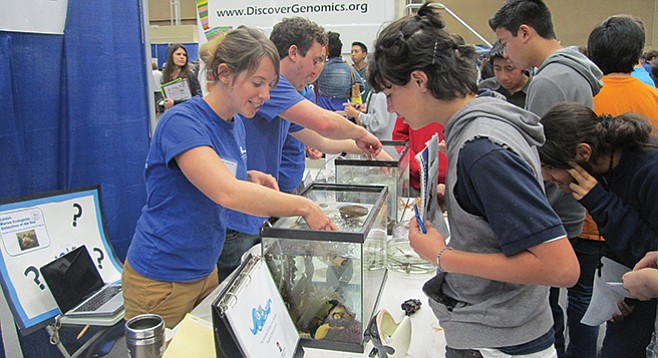 Facebook
Facebook
 X
X
 Instagram
Instagram
 TikTok
TikTok
 Youtube
Youtube

San Diego State’s Coastal and Marine Institute Laboratory is located on a strip between Lindbergh’s terminal 2 parking lot and the channel that separates the airport from Liberty Station. The acre-and-a-quarter property boasts outdoor aquaria, a greenhouse, a boat maintenance area, scuba diving facility, and a flow of seawater from the bay.
The focus of the laboratory’s work includes studying problems along the coast caused by human density. For example, within a few days of a decent rain, runoff raises bacteria levels that make ocean activities risky.
The San Diego State lab will host its Marine Science Day on Sunday, March 19, from 10:00 a.m. to 3:00 p.m. Some of the day’s hourly lectures by SDSU faculty and students: “Climate change and marine ecosystems,” “California spiny lobster fishery in the face of climate change,” “How do microbes keep sharks healthy?” “An overview of the city of San Diego’s coastal monitoring program,” “California seagrass meadows,” “How storm disturbances will impact kelp forest communities in San Diego.”
Some of the hourly activity labs: “Explore the world of microbes,” “What is the role of plankton in our oceans?,” “I get by with a little kelp from my friends,” “Sea Squirts: your most closely related invertebrate relative,” “Disrupted food webs,” “Why do seabirds eat plastic?”
Some 500 visitors attended last year’s event, whose theme was the effects of El Niño on the environment. This year, the topic is “Changing Coastlines in San Diego,” and included in the planned family-friendly activities is an interactive marine life touch tank housing sea squirts and starfish, hourly student and faculty presentations, and scuba-gear demonstrations.


San Diego State’s Coastal and Marine Institute Laboratory is located on a strip between Lindbergh’s terminal 2 parking lot and the channel that separates the airport from Liberty Station. The acre-and-a-quarter property boasts outdoor aquaria, a greenhouse, a boat maintenance area, scuba diving facility, and a flow of seawater from the bay.
The focus of the laboratory’s work includes studying problems along the coast caused by human density. For example, within a few days of a decent rain, runoff raises bacteria levels that make ocean activities risky.
The San Diego State lab will host its Marine Science Day on Sunday, March 19, from 10:00 a.m. to 3:00 p.m. Some of the day’s hourly lectures by SDSU faculty and students: “Climate change and marine ecosystems,” “California spiny lobster fishery in the face of climate change,” “How do microbes keep sharks healthy?” “An overview of the city of San Diego’s coastal monitoring program,” “California seagrass meadows,” “How storm disturbances will impact kelp forest communities in San Diego.”
Some of the hourly activity labs: “Explore the world of microbes,” “What is the role of plankton in our oceans?,” “I get by with a little kelp from my friends,” “Sea Squirts: your most closely related invertebrate relative,” “Disrupted food webs,” “Why do seabirds eat plastic?”
Some 500 visitors attended last year’s event, whose theme was the effects of El Niño on the environment. This year, the topic is “Changing Coastlines in San Diego,” and included in the planned family-friendly activities is an interactive marine life touch tank housing sea squirts and starfish, hourly student and faculty presentations, and scuba-gear demonstrations.
Comments